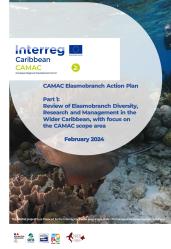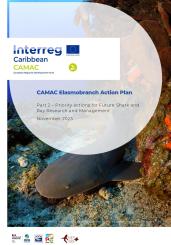An action plan to improve knowledge of elasmobranchs
in the Wider Caribbean Region
Sharks and rays, these 2 suborders of cartilaginous fish belonging to the Elasmobranchs, help to maintain the balance of marine ecosystems and are also useful to human economies, such as fishing and blue tourism. In addition, some of the elasmobranch species found in the Caribbean are threatened, so it is essential to protect them.
As part of the CAMAC project, an inventory of knowledge about sharks and rays in the Wider Caribbean Region has been produced. This study shows the great diversity of species in the area and highlights the lack of monitoring and research activities, as well as inconsistent protection measures between territories.
threatened species of rays and sharks
according to the IUCN Red List
Many elasmobranch species in the region are migratory or highly migratory. One of the major challenges highlighted by this study, and emphasised by the experts interviewed, is the need to strengthen collaboration between countries in order to better understand and manage these species throughout their range. An action plan has been produced to this end as part of CAMAC.
The experts brought together to produce this action plan identified 23 actions classified by priority and grouped into 3 areas of interest:
- New research efforts
- Research foundations
- Skills and capacity building
Each action is detailed in a fact sheet setting out all the key elements, such as the target species, the target habitats, the potential partners, the detailed budget and the human and material resources required.
The implementation and success of this action plan depends on local and regional commitment and collaboration. The knowledge acquired will be used to make recommendations for better protection of species and the sustainable development of human activities.
Consult the bibliographical study and the action plan in the documents below

CAMAC Elasmobranch bibliographic review
This bibliographical study reviews the current state of knowledge about elasmobranchs in the Caribbean.

CAMAC elasmobranch priority actions
This action plan proposes detailed action sheets to improve knowledge of the rays and sharks of the Caribbean.


